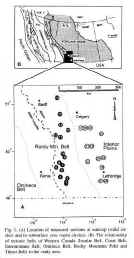|
Palaeogeography, Palaeoclimatology,
Palaeoecology, 143(1998), 87-110
USE OF MICROMORPHOLOGY FOR
PALAEOENVIRONMENTAL INTERPRETATION OF COMPLEX ALLUVIAL PALAEOSOLS: AN EXAMPLE
FROM THE MILL CREEK FORMATION (ALBIAN), SOUTHWESTERN ALBERTA, CANADA
PAUL J. MCCARTHY1 , I. PETER
MARTINI1 and DALE A. LECKIE2
1Department
of Land Resource Science, University of Guelph, Guelph, Ontario, Canada N1G 2W1
2Institute of Sedimentary and
Petroleum Geology, Geological Survey of Canada, 3303-33rd St., N.W., Calgary,
Alberta, Canada T2W 2A7
¡¡
 Field observations are often not sufficient
for process-based interpretations of palaeosols, particularly where they form
parts of thick aggradational pedocomplexes within alluvial successions. Under
such conditions micromorphology provides genetic, temporal and spatial
information on soil-forming processes that is critical to an understanding of
past environmental conditions. Thick alluvial successions of the Albian Mill
Creek Formation contain abundant evidence of pedogenesis, but few well-developed
palaeosol profiles, and therefore, provide an ideal case study in which to
demonstrate the usefulness of micromorphological data for palaeoenvironmental
interpretation. The micromorphological features of greatest interpretive value
are types of clay coatings and ferruginous segregations, structure and fabric.
Papules, evidence of bioactivity and ferruginous concretions provide information
on geomorphic surface stability and assist in reconstructing temporal changes in
drainage conditions. While individual features can provide some
palaeoenvironmental information, the relationships of features to one another
and assemblages of features provides additional information when analysed
hierarchically to establish a sequence of sedimentologic and pedogenic events. A
common, recurring sequence of palaeoenvironmental events, subject to local
variations, can be recognized throughout the Mill Creek Formation. The presence
of illuvial clay requires that water percolated through the soil and that the
soil periodically dried out so that the translocated clay was retained. Dark
reddish clay coatings indicate clay illuviation under freely drained conditions,
while pale-yellow and silty clay coatings suggest that phases of free drainage
alternated with phases of poorly drained or saturated soil conditions. The
presence of iron-depletion coatings, iron nodules and quasiferrans indicates
that these units were at least periodically saturated, and the occurrence of
multiple, overlapping phases within single thin sections demonstrates that redox
conditions fluctuated, strongly suggesting development in the vadose zone.
Recent soils containing similar assemblages of features develop under warm
temperate seasonal climates. Alternating phases of well-drained and saturated
conditions on the Mill Creek floodplains are attributed to changing sediment
supply and local palaeogeomorphology rather than to any major regional climate
change. This type of process-based, micromorphological analysis should have
broad application in other complex, pedogenically modified alluvial successions
and similar studies would lead to a more detailed understanding of ancient
palaeoenvironments. Field observations are often not sufficient
for process-based interpretations of palaeosols, particularly where they form
parts of thick aggradational pedocomplexes within alluvial successions. Under
such conditions micromorphology provides genetic, temporal and spatial
information on soil-forming processes that is critical to an understanding of
past environmental conditions. Thick alluvial successions of the Albian Mill
Creek Formation contain abundant evidence of pedogenesis, but few well-developed
palaeosol profiles, and therefore, provide an ideal case study in which to
demonstrate the usefulness of micromorphological data for palaeoenvironmental
interpretation. The micromorphological features of greatest interpretive value
are types of clay coatings and ferruginous segregations, structure and fabric.
Papules, evidence of bioactivity and ferruginous concretions provide information
on geomorphic surface stability and assist in reconstructing temporal changes in
drainage conditions. While individual features can provide some
palaeoenvironmental information, the relationships of features to one another
and assemblages of features provides additional information when analysed
hierarchically to establish a sequence of sedimentologic and pedogenic events. A
common, recurring sequence of palaeoenvironmental events, subject to local
variations, can be recognized throughout the Mill Creek Formation. The presence
of illuvial clay requires that water percolated through the soil and that the
soil periodically dried out so that the translocated clay was retained. Dark
reddish clay coatings indicate clay illuviation under freely drained conditions,
while pale-yellow and silty clay coatings suggest that phases of free drainage
alternated with phases of poorly drained or saturated soil conditions. The
presence of iron-depletion coatings, iron nodules and quasiferrans indicates
that these units were at least periodically saturated, and the occurrence of
multiple, overlapping phases within single thin sections demonstrates that redox
conditions fluctuated, strongly suggesting development in the vadose zone.
Recent soils containing similar assemblages of features develop under warm
temperate seasonal climates. Alternating phases of well-drained and saturated
conditions on the Mill Creek floodplains are attributed to changing sediment
supply and local palaeogeomorphology rather than to any major regional climate
change. This type of process-based, micromorphological analysis should have
broad application in other complex, pedogenically modified alluvial successions
and similar studies would lead to a more detailed understanding of ancient
palaeoenvironments.
|